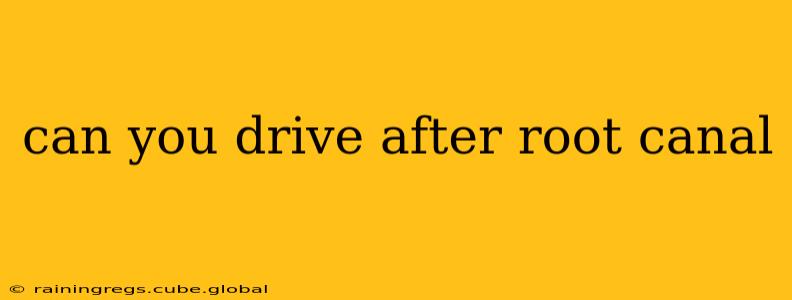Getting a root canal is a significant dental procedure, and it's natural to wonder about the potential impact on your daily activities afterward. One common question is: Can you drive after a root canal? The short answer is generally yes, but with some important caveats. The impact on your ability to drive safely depends on several factors, including your individual reaction to anesthesia and any pain medication prescribed.
What Happens During a Root Canal?
Before addressing driving, let's briefly understand what a root canal entails. During this procedure, the infected pulp (the inner part of your tooth containing nerves and blood vessels) is removed, the canals are cleaned and shaped, and then filled and sealed. This process typically involves local anesthesia to numb the area.
How Anesthesia Affects Driving Ability
The primary factor affecting your ability to drive after a root canal is the local anesthesia. While it numbs the targeted area, some individuals may experience lingering effects such as:
- Numbness or altered sensation: This can affect your mouth, lips, and even parts of your face, making it difficult to control your facial muscles and potentially impacting your ability to speak clearly or react quickly.
- Drowsiness or dizziness: Some anesthetics can cause drowsiness or dizziness, significantly impairing your driving abilities. This is especially true if combined with any prescribed pain medication.
- Impaired coordination: Although rare, some individuals experience temporary impaired coordination or balance after receiving local anesthesia.
These effects can vary depending on the type and amount of anesthesia used, as well as your individual sensitivity and metabolism. It's crucial to prioritize safety and avoid driving until these effects have completely worn off.
The Role of Pain Medication
Your dentist might prescribe pain medication to manage any post-procedure discomfort. Many common pain relievers, such as ibuprofen or acetaminophen, can cause drowsiness if taken in higher doses or in combination with other medications. Never drive while taking pain medication that causes drowsiness or dizziness. Always carefully read the medication label and follow your dentist's instructions.
How long should I wait before driving after a root canal?
There's no universal waiting period. The best approach is to wait until the numbness and any other effects of the anesthesia have completely subsided and you feel fully alert and able to react normally. This could take a few hours, or even longer depending on the individual. If you're unsure, it's always best to err on the side of caution and arrange for an alternative mode of transportation.
Can I drive if I only had local anesthesia?
Even with only local anesthesia, it's crucial to assess your condition before driving. While the effects are typically less pronounced than with stronger anesthesia, you might still experience lingering numbness or slight dizziness. Prioritize your safety and the safety of others by waiting until you feel completely recovered.
What if I feel any pain after the procedure?
Post-procedure pain is normal, but if it's severe or unmanageable, contact your dentist immediately. They can advise on appropriate pain management and help determine if driving is safe.
Are there any alternative transportation options?
If you're unsure about driving after your root canal, consider alternative transportation options such as:
- Asking a friend or family member to drive you home.
- Using a ride-sharing service.
- Taking a taxi or public transportation.
Prioritizing your safety and the safety of others on the road is paramount. Never compromise your well-being for the sake of driving.
In conclusion, while driving after a root canal is generally possible, it’s crucial to assess your individual response to anesthesia and pain medication. Prioritize your safety and the safety of others by waiting until you're fully alert, your senses are back to normal, and you feel completely comfortable driving. When in doubt, always choose a safer alternative mode of transportation.
